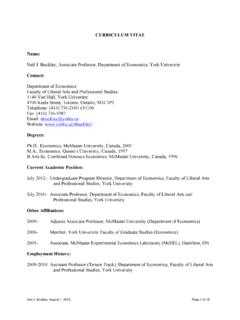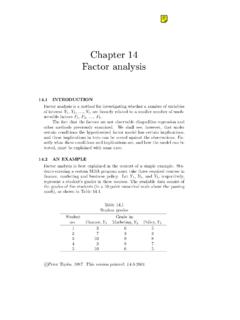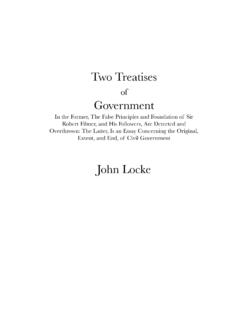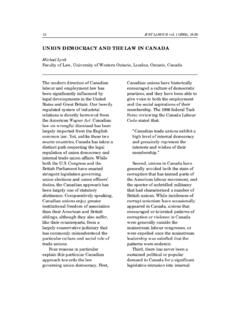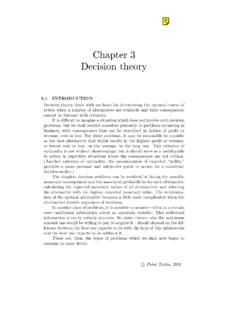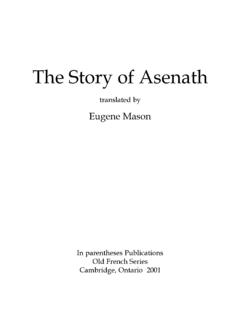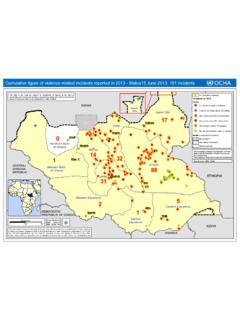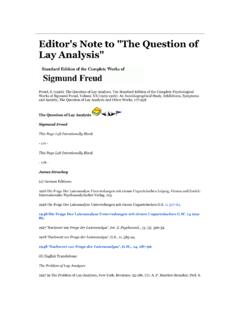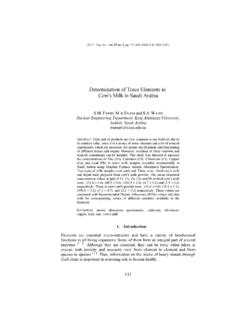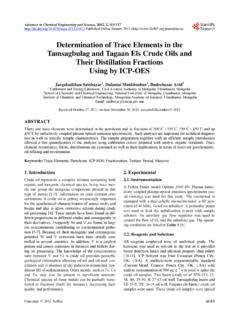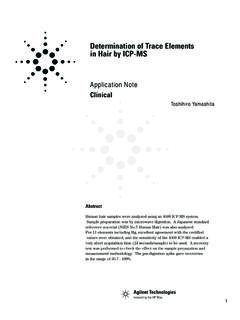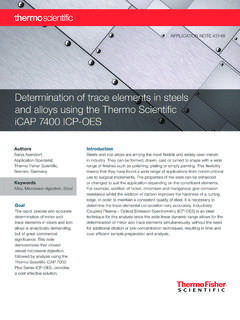Transcription of DETERMINATION OF TRACE ELEMENT BY ATOMIC …
1 Suvardhan, K., K. Suresh Kumar, Reddy, P. Chiranjeevi DETERMINATION Of TRACE ELEMENT By ATOMIC Absorption Spectroscopy (Aas) After Preconcentration On A Support Impregnated With coniine Dithiocarbamate in Martin J. Bunch, V. Madha Suresh and T. Vasantha Kumaran, eds., Proceedings of the Third International Conference on Environment and Health, Chennai, India, 15-17 December, 2003. Chennai: Department of Geography, University of Madras and Faculty of Environmental Studies, York University. Pages 562 569. DETERMINATION OF TRACE ELEMENT BY ATOMIC ABSORPTION SPECTROSCOPY (AAS) AFTER PRECONCENTRATION ON A SUPPORT IMPREGNATED WITH coniine DITHIOCARBAMATE K. Suvardhan, K. Suresh Kumar, Reddy, P.
2 Chiranjeevi* *Environmental Monitoring Section, Dept. of Chemistry, , Tirupati-517 502, , India, E-mail : Abstract A procedure is developed for the DETERMINATION of Cd, Cu, Mo, Pb, Te and Ni in water by ATOMIC Absorption Spectroscopy (AAS) after preconcentration on a coniine dithiocarbamate supported by polyurethane. The sorbed elements are subsequently eluted with 5 mol L-1 HNO3 and the acid eluates are analysed by AAS. A 20 mL syringe served as a chromatographic preconcentration column. The sorption recoveries of elements were higher in the order of 99%. The method is also applied successfully for the DETERMINATION of Cu, Cd, Mo, Pb, Te and Ni in natural and spiked water samples.
3 Introduction Environmental pollution monitoring requires DETERMINATION of toxic heavy elements in TRACE levels. The ATOMIC Absorption Spectrometry (AAS) technique, which offers fast multielemental analysis, suffers from a poor sensitivity in the DETERMINATION of heavy elements in environmental samples like natural water and other real samples. This draw back can be overcome by a combination of a suitable preconcentration technique with subsequent AAS DETERMINATION . Preconcentration methods that can be used for water samples are solvent extraction, coprecipitation, resin chelation and various chromatographic technique1-8.
4 These preconcentration methods provides low detection limits and also help to avoid matrix interferences in the analysis of real samples. Extraction of the dithiocarbamate complexes of metals in the isobutyl methyl ketone (1 BMK) and subsequent DETERMINATION has been widely applied in the DETERMINATION of metals in natural water. However, this simple solvent extraction concentration procedure cannot be combined with AAS9-10. In view of this, several workers tried a column solid phase extraction method for the DETERMINATION of metals by AAS. Column solid-phase extraction has some advantages over liquid-liquid extraction.
5 The possibility of combination with ICP-AES as well as with AAS allows preconcentration from a larger sample volume, establishing higher concentration factors, simple storage and transportation of the pretreated samples11. Here authors report a method for preconcentration of TRACE elements , viz., Cd, Cu, Mo, Pb, Te and Ni on a polyurethane foam support impregnated with coniine dithiocarbamate. The sorbed elements were sequently eluted with 5 mol L-1 HNO3. The acid eluates were further analysed by AAS. Experimental Material and Methods All reagents and chemicals used were of Analytical reagent grade.
6 Deionized doubly distilled water was used through out the experiments. A multielement standard solution ( mg mL-1) was prepared by appropriate dilution of AAS standards (Merck Germany) of Cd, Cu, Mo, Pb, Te and Ni. Working standards of ( , , , and g mL-1) were prepared by appropriate dilution of multielement standard with deionized distilled water. Nitric acid was used with out additional purification. Sodium salt of coniine dithiocarbamate was prepared by slowly adding 80g of carbondi-sulphide to a solution of coniine (85g) in 25 mL of water at 50C with constant stirring, followed by 40 g of sodium hydroxide dissolved in 20 mL of water as shown in The product was warmed to room temperature, washed repeatedly two or three times with purified acetone.
7 The reaction product was purified by recrystalization in acetone. The compound thus produced has a melting point of 303-3080C at 740 mm pressure. Acetate buffer was prepared by dissolving g sodium acetate in 800 mL water. It was adjusted by pH with high purity glacial acetic acid. It was stored in a clean polyethylene bottle. 20 plus varian ATOMIC absorption spectrometer with a hallow cathode lamp, using an N2O - acetylene flame for DETERMINATION of traces of heavy metals. The AAS NHCH2CH2CH3CS2 NCSS-Na+ConiineCarbondisulphideConiine : Synthesis of coniine dithiocarbamate of all other cations was performed under the recommended conditions for each metal.
8 The pH was determined with a model 632 Metrohm pH meter with a combined glass-calomel electrode. Column Preparation Medical Syringes (20 mL) were used as columns. The support was prepared from soft polyurethane foam in the following manner. 1 cm thick segments with diameter of cm were cut. The segments were soaked in 5 mol L-1 nitric acid for 15 h, washed in deionized doubly distilled water and dried prior to use. The syringes were then filled with the air-dried segments. The column consists 7-8 separate segments. Then g of solid coniine dithiocarbamate was introduced between the segments.
9 This amount of the complex forming agent was necessary to retain the 100 g of each ELEMENT in 200 mL sample. Prior to passing the next 200 mL sample, an additional g of solid coniine dithiocarbamate was introduced in to the column by replacing the polyurethane foam segments with a new set of segments. Procedure The 20 mL of standard solution containing elements Cd, Cu, Mo, Pb, Te and Ni was taken and the pH was adjusted to 6 " with ammonia solution (1:1) or HCl (1+1) and 2 mL of acetate buffer. The solution of the elements was sucked in the column and allowed to contact for 30 min, then the liquid phase was allowed to drain by removing the piston.
10 Elution was performed by adding 10 mL of 5 mol L-1 HNO3 to the column by removing the piston. This solution was then allowed to pass through the column. The acid eluent was collected in the polyethylene bottle. Then 2 ml of double distilled water was added and the eluent was collected. Both the eluents were combined and nebulized in to N2O - acetylene flame of AAS. Preconcentration of TRACE elements in Natural Water Samples Water sample (200 mL) filtered through a m membrane filter was taken and pH was adjusted to 6" with HCl (1+1) or dilute ammonia solution (1:1) and 2 mL of acetate buffer, and passed through the chromatographic columns at a flow rate of 2 mL min-1.
